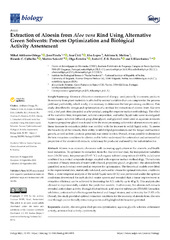Приказ основних података о документу
Extraction of Aloesin from Aloe vera Rind Using Alternative Green Solvents: Process Optimization and Biological Activity Assessment
| dc.creator | Añibarro-Ortega, Mikel | |
| dc.creator | Pinela, José | |
| dc.creator | Ćirić, Ana | |
| dc.creator | Lopes, Elsa | |
| dc.creator | Molina, Adriana K. | |
| dc.creator | Calhelha, Ricardo C. | |
| dc.creator | Soković, Marina | |
| dc.creator | Ferreira, Olga | |
| dc.creator | Ferreira, Isabel C. F. R. | |
| dc.creator | Barros, Lillian | |
| dc.date.accessioned | 2021-10-14T12:47:27Z | |
| dc.date.available | 2021-10-14T12:47:27Z | |
| dc.date.issued | 2021 | |
| dc.identifier.issn | 2079-7737 | |
| dc.identifier.uri | https://www.mdpi.com/2079-7737/10/10/951 | |
| dc.identifier.uri | https://radar.ibiss.bg.ac.rs/handle/123456789/4488 | |
| dc.description.abstract | Aloesin is an aromatic chromone with increasing applications in the cosmetic and health food industries. To optimize its extraction from the Aloe vera leaf rind, the independent variables time (10–210 min), temperature (25–95 °C) and organic solvent composition (0–100%, w/w) were combined in a central composite design coupled with response surface methodology. The solvents consisted of binary mixtures of water with ethanol, propylene glycol, or glycerol. The aloesin levels quantified in each extract were used as response for optimization. The theoretical models were fitted to the experimental data, statistically validated, and used to obtain the optimal extraction conditions. Then, a dose–response analysis of the solid/liquid ratio (S/L) was performed under the optimal conditions determined for each alcohol–water system and revealed that a linear improvement in extraction efficiency can be achieved by increasing the S/L ratio by up to 40 g/L. This analysis also allowed to experimentally validate the predictive models. Furthermore, the aloesin-rich extracts revealed antioxidant activity through thiobarbituric acid reactive substances (TBARS) formation inhibition, antimicrobial effects against bacterial and fungal strains, and no toxicity for PLP2 cells. Overall, this study provided optimal extraction conditions for the recovery of aloesin from Aloe vera rind through an eco-friendly extraction process and highlighted its bioactive potential. | |
| dc.publisher | Basel: MDPI | |
| dc.relation | info:eu-repo/grantAgreement/MESTD/Basic Research (BR or ON)/173032/RS// | |
| dc.rights | openAccess | |
| dc.rights.uri | https://creativecommons.org/licenses/by/4.0/ | |
| dc.source | Biology | |
| dc.title | Extraction of Aloesin from Aloe vera Rind Using Alternative Green Solvents: Process Optimization and Biological Activity Assessment | |
| dc.type | article | en |
| dc.rights.license | BY | |
| dcterms.abstract | Баррос, Лиллиан; Молина, Aдриана К.; Пинела, Јосé; Añибарро-Ортега, Микел; Лопес, Елса; Соковић, Марина; Ферреира, Олга; Цалхелха, Рицардо Ц.; Ферреира, Исабел Ц. Ф. Р.; Ћирић, Aна; | |
| dc.rights.holder | © 2021 by the authors. Licensee MDPI, Basel, Switzerland. | |
| dc.citation.issue | 10 | |
| dc.citation.volume | 10 | |
| dc.identifier.doi | 10.3390/biology10100951 | |
| dc.identifier.scopus | 2-s2.0-85116050109 | |
| dc.identifier.wos | 00081532850000 | |
| dc.citation.apa | Añibarro-Ortega, M., Pinela, J., Ćirić, A., Lopes, E., Molina, A. K., Calhelha, R. C., et al. (2021). Extraction of Aloesin from Aloe vera Rind Using Alternative Green Solvents: Process Optimization and Biological Activity Assessment. Biology, 10(10), 951. | |
| dc.citation.vancouver | Añibarro-Ortega M, Pinela J, Ćirić A, Lopes E, Molina AK, Calhelha RC, Soković M, Ferreira O, Ferreira ICFR, Barros L. Extraction of Aloesin from Aloe vera Rind Using Alternative Green Solvents: Process Optimization and Biological Activity Assessment. Biology (Basel). 2021;10(10):951. | |
| dc.citation.spage | 951 | |
| dc.type.version | publishedVersion | |
| dc.identifier.fulltext | https://radar.ibiss.bg.ac.rs/bitstream/id/9301/biology-10-00951-v2.pdf | |
| dc.citation.rank | M21 |

